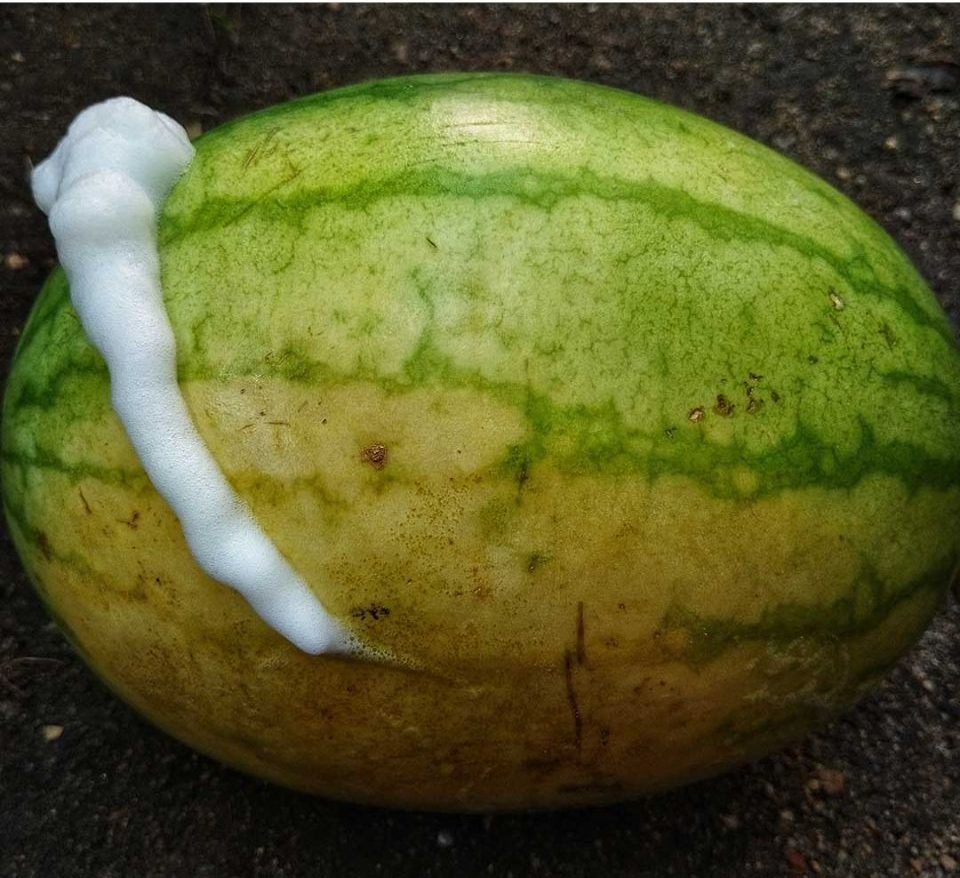Watermelons are a refreshing and delicious summer fruit, loved for their juicy, sweet taste and hydrating properties. However, under certain conditions, watermelons can exhibit a surprising and alarming behavior: foaming.
If you notice your watermelon foaming, it’s crucial to act quickly. This phenomenon, while uncommon, can signal potential safety hazards. Here’s what you need to know and the steps you should take to ensure your safety.
Why Is My Watermelon Foaming?
Foaming in watermelons is often due to fermentation, which occurs when yeast or bacteria begin to break down the sugars in the fruit. This process generates carbon dioxide gas, which can create foam. The causes of this fermentation can vary:
- Overripe Fruit: When a watermelon becomes overly ripe, the natural sugars within it start breaking down more rapidly, making the fruit more susceptible to fermentation.
- Microbial Contamination: If a watermelon is contaminated with yeast or bacteria, these microbes can feed on the sugars in the fruit, leading to fermentation. Contamination can occur if the watermelon has a puncture or crack in the rind, allowing microbes to enter.
- Temperature Changes: Watermelons that are stored in fluctuating temperatures or in warm conditions for extended periods can begin to ferment. This is because warm environments are conducive to microbial growth and activity.
- Pesticide or Chemical Residue: In some rare cases, chemical residues on the fruit’s skin can lead to chemical reactions that cause foaming. While this is less common, it’s a possibility worth considering.
Is a Foaming Watermelon Dangerous?
Yes, a foaming watermelon can be dangerous. Here’s why:
- Food Poisoning Risk: If fermentation is caused by harmful bacteria, consuming the watermelon can lead to foodborne illnesses. Symptoms might include stomach cramps, nausea, vomiting, and diarrhea.
- Chemical Contamination: If the foaming is due to chemical reactions involving pesticides or other substances, there could be a risk of chemical poisoning.
- Physical Hazard: In rare cases, a watermelon that has been fermenting for a while could burst due to the buildup of gases inside. This could cause injury from flying fragments of the rind.

Immediate Steps to Take if Your Watermelon Is Foaming
If you notice that your watermelon is foaming, follow these steps immediately:
1. Do Not Consume the Watermelon
The first and most crucial step is to avoid eating any part of the foaming watermelon. The foam and the flesh of the fruit could be contaminated with harmful bacteria or chemicals. Consuming it could pose serious health risks.
2. Isolate the Watermelon
Remove the watermelon from your kitchen or dining area to avoid contaminating other foods or surfaces. Place it in a plastic bag or container to contain any further foaming or leakage.
3. Dispose of the Watermelon Safely
Dispose of the watermelon in an outdoor trash bin, away from pets and children. Ensure that the trash bin is sealed to prevent animals from accessing it and potentially spreading the contamination.
4. Clean and Disinfect Surfaces
Clean any surfaces that came into contact with the watermelon with hot, soapy water. Follow up by disinfecting with a suitable cleaning agent to eliminate any bacteria or chemical residue.
5. Wash Your Hands Thoroughly
After handling the foaming watermelon and cleaning the surfaces, wash your hands thoroughly with soap and water. This step is vital to prevent the spread of any potential contaminants.
6. Monitor for Symptoms of Illness
If you or anyone in your household accidentally consumed the foaming watermelon, monitor for symptoms such as stomach pain, nausea, vomiting, or diarrhea. If any symptoms develop, seek medical attention immediately.
7. Report the Incident
Consider reporting the incident to your local health department, especially if you suspect the foaming was caused by chemical contamination or if multiple watermelons in your area are showing the same signs. This can help authorities identify potential food safety issues and prevent others from becoming ill.
Preventing Watermelon Foaming in the Future
While foaming watermelons are relatively rare, taking some preventive measures can reduce the risk of encountering this problem:
1. Inspect Before Purchasing
When buying a watermelon, inspect it carefully. Look for signs of damage, such as cracks, punctures, or soft spots, which can allow bacteria to enter. Also, avoid watermelons with an overly shiny or sticky rind, as these could indicate chemical residue.
2. Store Properly
Store watermelons in a cool, dry place. Avoid exposing them to direct sunlight or warm temperatures for extended periods. If you cut a watermelon, refrigerate any unused portions immediately in a sealed container.
3. Wash Before Cutting
Before cutting into a watermelon, wash the rind thoroughly with water. This helps remove any dirt, bacteria, or chemicals that may be present on the surface.
4. Consume Promptly
Consume cut watermelon within a few days to minimize the risk of fermentation and spoilage. The longer cut fruit sits, the higher the risk of bacterial growth and fermentation.
Seeing a watermelon foam up can be a surprising and concerning experience. While it’s not a common occurrence, it’s important to understand that foaming can indicate potential health risks, from bacterial contamination to chemical exposure. By knowing the steps to take immediately and following preventive measures, you can protect yourself and your loved ones from the dangers of a foaming watermelon. Always prioritize safety and when in doubt, it’s better to dispose of the fruit than to risk consuming something that could harm your health.
Source: cooktopcove







